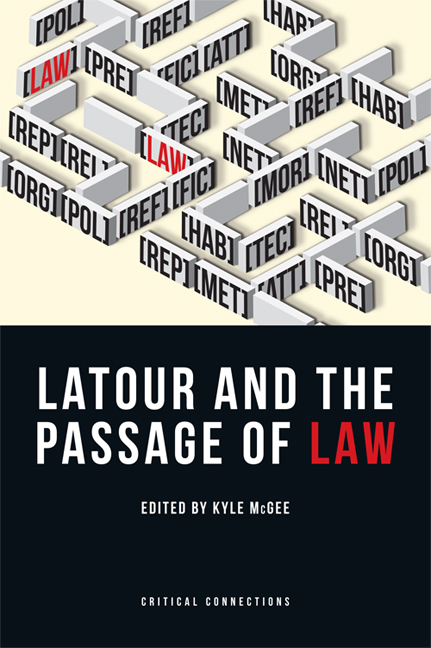Book contents
- Frontmatter
- Contents
- Introduction
- 1 From the Conseil d’État to Gaia: Bruno Latour on Law, Surfaces and Depth
- 2 Politics and Law as Latourian Modes of Existence
- 3 On Devices and Logics of Legal Sense: Toward Socio-technical Legal Analysis
- 4 ‘The Crown Wears Many Hats’: Canadian Aboriginal Law and the Black-boxing of Empire
- 5 Providing the Missing Link: Law after Latour's Passage
- 6 The Life and Deaths of a Dispute: An Inquiry into Matters of Law
- 7 Plasma! Notes on Bruno Latour's Metaphysics of Law
- 8 The Conditions of a Good Judgment: From Law to Internal Affairs Police Investigations
- 9 In The Name of the Law: Ventriloquism and Juridical Matters
- 10 Laboratory Life and the Economics of Science in Law
- 11 Bartleby, Barbarians and the Legality of Literature
- 12 The Strange Entanglement of Jurimorphs
- List of Contributors
- Index
9 - In The Name of the Law: Ventriloquism and Juridical Matters
Published online by Cambridge University Press: 05 September 2016
- Frontmatter
- Contents
- Introduction
- 1 From the Conseil d’État to Gaia: Bruno Latour on Law, Surfaces and Depth
- 2 Politics and Law as Latourian Modes of Existence
- 3 On Devices and Logics of Legal Sense: Toward Socio-technical Legal Analysis
- 4 ‘The Crown Wears Many Hats’: Canadian Aboriginal Law and the Black-boxing of Empire
- 5 Providing the Missing Link: Law after Latour's Passage
- 6 The Life and Deaths of a Dispute: An Inquiry into Matters of Law
- 7 Plasma! Notes on Bruno Latour's Metaphysics of Law
- 8 The Conditions of a Good Judgment: From Law to Internal Affairs Police Investigations
- 9 In The Name of the Law: Ventriloquism and Juridical Matters
- 10 Laboratory Life and the Economics of Science in Law
- 11 Bartleby, Barbarians and the Legality of Literature
- 12 The Strange Entanglement of Jurimorphs
- List of Contributors
- Index
Summary
From John Langshaw Austin (1962) to Jacques Derrida (1992) through Harold Garfinkel (1967), scholars studying language and social interaction have often been intrigued by the judicial scene, a scene where testimonies, exhibits, evidence, texts of law and precedents regularly define the fate of specific cases and individuals (Heritage 1984; Bruner 2003). If Austin insisted on the performative dimension of judicial utterances, Garfinkel analysed the interpretive methods jurors use to justify their decisions for another next first time, while Derrida explored the gap that seems to always separate law from justice.
Beyond their differences, however, all these contributions point to the performative or eventful character of law, i.e. the fact that law should be considered an achievement or accomplishment in its haecceity, as Garfinkel (2002) would say. However, they also point – and this is the paradox – to its iterative, uneventful and institutional character, that is, that this performativity should also be considered the product of a specific context, structure or frame that authorises or legitimises certain moves and dictates or prescribes how imputations should be established. Something called ‘Law’ is thus supposed to iteratively and repeatedly find its passage through these performances, since any judicial decision has to be the application, incarnation or embodiment of specific rules that permit, justify or substantiate it.
In this chapter, I will explore this tension by showing how the judicial scene can be considered a dislocated locus where various entities can be made to speak and present themselves, defining the contours and substance of a given case. According to this approach, we do not need to choose between eventfulness and iteration or even between action and structure/system. What we need to show, however, is how different elements of the so-called ‘context’ of a given scene are, in fact, made to say things in a situation of interlocution, thus becoming active participants in what is happening. Using the metaphor of ventriloquism (Cooren 2010, 2012; Goldblatt 2006), I will show – both theoretically and empirically – how participants in legal processes constantly make facts, principles, precedents and texts of law, i.e. say and do things, which come to define what Bruno Latour (2010) would call the making and passage of law.
- Type
- Chapter
- Information
- Latour and the Passage of Law , pp. 235 - 272Publisher: Edinburgh University PressPrint publication year: 2015



